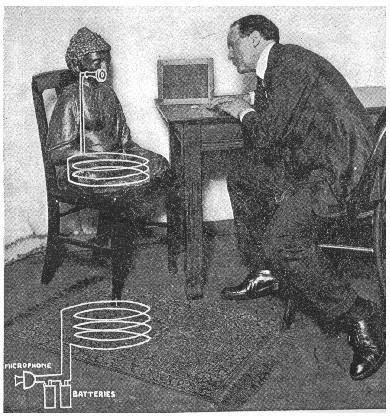"...the first application of the principles of radio to spiritualistic manifestations was in 1852, when Jonathan Koons, a farmer of Dover Village, Ohio, installed a “spirit machine”—described as a “crude structure of zinc and copper for localizing and collecting the magnetic aura.” But in the magician’s detailed account of this ancient trick he tells us that the apparatus consisted merely of hidden speaking-tubes that led to a confederate in the next room, known as the “invisible girl."It's an interesting theory, anyway, and one that Houdini himself was able to aptly demonstrate. But as we've come to expect from Houdini's séance-busting efforts, the means are overly-elaborate, and a reflection of the magician's reliance on mechanical means to produce manifestations. Houdini must not have known that the spirit room was not located in the proximity of the Koons' farmhouse, and was a simple freestanding, dirt-floored log cabin routinely inspected by hundreds if not thousands. And he likely didn't research the accounts of the crowds that often assembled around the room during seance sessions, hampering any chance of an outside confederate. No, as is usual for Houdini and his other like him--as much as I love them the whole motley crew--the magician resorts to grand mechanical theories to explain relatively simple psychical phenomena, and fails to account for the skills of a talented medium in a dark room filled with believers. But it's an act I'd most certainly like to experience.
Thursday, November 20, 2014
The Invisible Girl: Houdini Evaluates Koons, 1922
Koons' "Spiritual Machine." It appears Houdini weighed in on the table's true
purpose--though generations later and wholly incorrectly--when he
claimed in the October 21, 1922 Literary Digest
that Koons' table was merely an elaborate transmitter for a hidden
accomplice, which demonstrates his failed understanding of the reported
phenomena, more than anything:
Subscribe to:
Comments (Atom)

